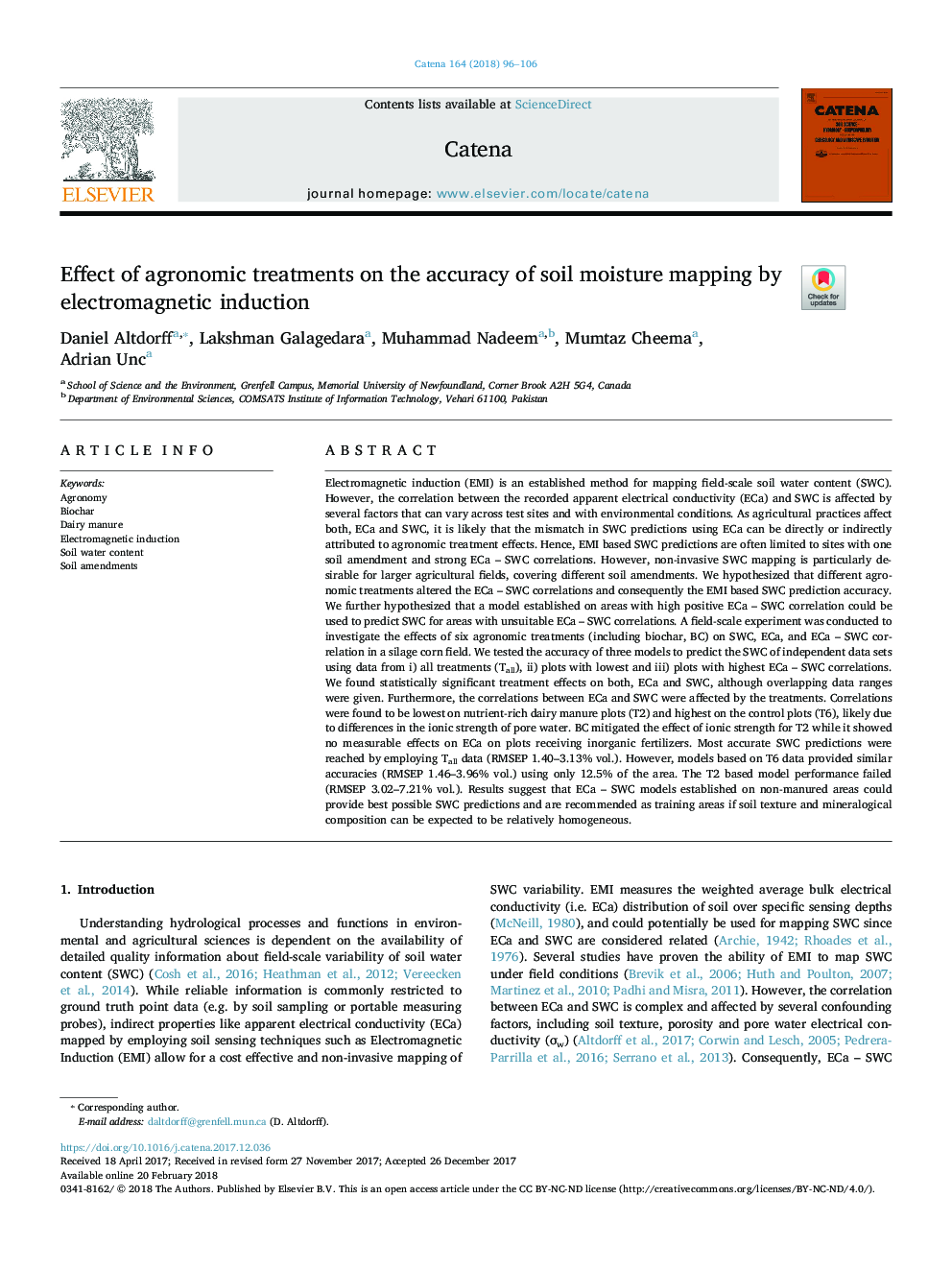| کد مقاله | کد نشریه | سال انتشار | مقاله انگلیسی | نسخه تمام متن |
|---|---|---|---|---|
| 8893661 | 1629190 | 2018 | 11 صفحه PDF | دانلود رایگان |
عنوان انگلیسی مقاله ISI
Effect of agronomic treatments on the accuracy of soil moisture mapping by electromagnetic induction
ترجمه فارسی عنوان
اثر تیمارهای زراعی بر دقت نقشه بندی رطوبت خاک با القای
دانلود مقاله + سفارش ترجمه
دانلود مقاله ISI انگلیسی
رایگان برای ایرانیان
کلمات کلیدی
موضوعات مرتبط
مهندسی و علوم پایه
علوم زمین و سیارات
فرآیندهای سطح زمین
چکیده انگلیسی
Electromagnetic induction (EMI) is an established method for mapping field-scale soil water content (SWC). However, the correlation between the recorded apparent electrical conductivity (ECa) and SWC is affected by several factors that can vary across test sites and with environmental conditions. As agricultural practices affect both, ECa and SWC, it is likely that the mismatch in SWC predictions using ECa can be directly or indirectly attributed to agronomic treatment effects. Hence, EMI based SWC predictions are often limited to sites with one soil amendment and strong ECa - SWC correlations. However, non-invasive SWC mapping is particularly desirable for larger agricultural fields, covering different soil amendments. We hypothesized that different agronomic treatments altered the ECa - SWC correlations and consequently the EMI based SWC prediction accuracy. We further hypothesized that a model established on areas with high positive ECa - SWC correlation could be used to predict SWC for areas with unsuitable ECa - SWC correlations. A field-scale experiment was conducted to investigate the effects of six agronomic treatments (including biochar, BC) on SWC, ECa, and ECa - SWC correlation in a silage corn field. We tested the accuracy of three models to predict the SWC of independent data sets using data from i) all treatments (Tall), ii) plots with lowest and iii) plots with highest ECa - SWC correlations. We found statistically significant treatment effects on both, ECa and SWC, although overlapping data ranges were given. Furthermore, the correlations between ECa and SWC were affected by the treatments. Correlations were found to be lowest on nutrient-rich dairy manure plots (T2) and highest on the control plots (T6), likely due to differences in the ionic strength of pore water. BC mitigated the effect of ionic strength for T2 while it showed no measurable effects on ECa on plots receiving inorganic fertilizers. Most accurate SWC predictions were reached by employing Tall data (RMSEP 1.40-3.13% vol.). However, models based on T6 data provided similar accuracies (RMSEP 1.46-3.96% vol.) using only 12.5% of the area. The T2 based model performance failed (RMSEP 3.02-7.21% vol.). Results suggest that ECa - SWC models established on non-manured areas could provide best possible SWC predictions and are recommended as training areas if soil texture and mineralogical composition can be expected to be relatively homogeneous.
ناشر
Database: Elsevier - ScienceDirect (ساینس دایرکت)
Journal: CATENA - Volume 164, May 2018, Pages 96-106
Journal: CATENA - Volume 164, May 2018, Pages 96-106
نویسندگان
Daniel Altdorff, Lakshman Galagedara, Muhammad Nadeem, Mumtaz Cheema, Adrian Unc,
